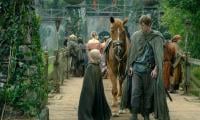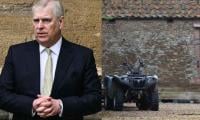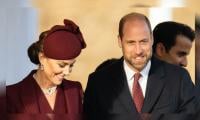Thailand chief monk visits Peshawar Museum, Takht Bhai ruins
PESHAWAR: A nine-member delegation from Thailand on Wednesday visited archaeological sites in Khyber Pakhtunkhwa and the Peshawar Museum.
The visitors evinced a keen interest in the findings and discoveries of Buddhism and Buddhist heritage.The delegation, comprising chief monks and monks, officials of Archaeology and Museums visited Takht Bhai ruins and Peshawar Museum and performed worship.
They also received a briefing on Peshawar Museum, Buddhism heritage sites in Khyber Pakhtunkhwa. Archaeology and Museums Director Dr Abdul Samad briefed the monks on the archaeological sites in Peshawar, Takht Bhai ruins, Buddhism, gallery of Buddhist statues, antiques and artefacts in the museum.
He said there were over 6,000 archaeological and heritage sites in Khyber Pakhtunkhwa, where the research was being carried out to revive these sites properly. “The followers of Buddhism would find a treasure trove of Buddhist statues and heritage after thorough research and revival of these sites,” the official told the delegation.
He said that Unesco had declared the Takht Bhai ruins a world heritage site in the year 1980, where thousands of ruins of Buddhism exist. Dr Abdul Samad said the government had taken several steps for attracting foreign tourists, scholars and researchers to the province.
The official said a comprehensive policy had been evolved for preserving and protecting the archaeological sites and places in Khyber Pakhtunkhwa. He mentioned the latest discoveries and the rich Gandhara heritage in various parts of the province.
The official said the government was giving top priority to repair, renovation and preservation of archaeological heritage, and historical buildings in the province. He said a plan had been chalked out to protect and preserve all ancient places and buildings properly.
About the Peshawar Museum, he said the historic Peshawar Museum was built in 1907. It is famous for its collection of Buddhist artwork dating from the ancient Gandhara Empire.Initially, DrSamad said, the museum had only one exhibition hall, but two more were added in 1969–70.
In 2004–05, the museum was further expanded with the construction of a new block with two galleries, two halls for the museum’s collection in storage, offices for the provincial directorate of archaeology, a conservation laboratory and a cafeteria.
The historic exhibition hall was also renovated at that time.The current collection has almost 14,000 items based on Gandhara, Greco-Buddhist, Kushan, Parthian, and Indo-Scythian life.
The museum showcases art, sculptures, coins, manuscripts, statues, ancient books, early versions of the Quran, weapons, dresses, jewellery, Kalash effigies, inscriptions, paintings of the Mughal and later periods, household materials and pottery as well as local and Persian handicrafts.
He said the Peshawar Museum has one of the largest and most extensive collections of Gandhara art of the Buddhist period and is considered to be one of the biggest collections of Buddhist objects in the world. It also contains the largest collection on Buddha. Buddhist stone sculptures, terracotta figurines and other Buddhist objects.
The display of Gandhara art in the main hall includes Buddha’s life stories, miracles, worship of symbols, relic caskets, and individual standing Buddha sculptures. The ethnological objects of that period are also exhibited in the museum.
He told the visitors that it has 8,625 coins, of which 4,510 are pre-Islamic. The main interest of the museum’s numismatic collection is that the coins were recovered from archaeological sites, including Shah-Ji-Ki-Dheri, Sari Bahlol, Takht-i-Bhai and Jamal Garhi.
The official added that the collections of Bactrian Greek, Indo-Greek, Indo-Scythian, Indo-Parthian and Kushan coins have been published.This gallery exhibits wooden facades of mosques, ancient Arabic and Persian inscriptions, fine Multani tiles and ceramics, and the dresses and weapons of Syed Ahmad Shaheed Barelvi and numerous ancient leaders.
Some of the best works are the Mughal Islamic metal artefacts in bronze and silver, the calligraphic specimens and scrolls that date as far back as 1224.The members of the delegation said that Peshawar was a historic and safe city. They said the people of Peshawar and elsewhere in Khyber Pakhtunkhwa were hospitable and friendly.
-
 Critics Get Honest About 'A Knight Of The Seven Kingdoms'
Critics Get Honest About 'A Knight Of The Seven Kingdoms' -
 Why Harry Unlikely To Meet William, Kate During UK Return?
Why Harry Unlikely To Meet William, Kate During UK Return? -
 X To Change AI Chatbot 'Grok' After Outrage Over Explicit Deepfake Images
X To Change AI Chatbot 'Grok' After Outrage Over Explicit Deepfake Images -
 Princess Eugenie Set To Hit New Milestone As Andrew's Eviction Looms
Princess Eugenie Set To Hit New Milestone As Andrew's Eviction Looms -
 Emilia Clarke Gets Honest About Featuring In Shows Like 'Game Of Thrones'
Emilia Clarke Gets Honest About Featuring In Shows Like 'Game Of Thrones' -
 Amazon Employees’ Break-time Fight Ends In Murder In Texas
Amazon Employees’ Break-time Fight Ends In Murder In Texas -
 Peter Jackson Reveals A Viggo Mortensen Mishap In 'LOTR' Fans Totally Missed
Peter Jackson Reveals A Viggo Mortensen Mishap In 'LOTR' Fans Totally Missed -
 Marsh Farm: Work Underway On Andrew Mountbatten-Windsor's New Home
Marsh Farm: Work Underway On Andrew Mountbatten-Windsor's New Home -
 'Rip' Director Dishes On Matt Damon, Ben Affleck's ‘brotherly’ Dynamic
'Rip' Director Dishes On Matt Damon, Ben Affleck's ‘brotherly’ Dynamic -
 Meghan Markle Handed Strict Warning: ‘You’re Playing With Fire In A High Risk, High Noise’ Game’
Meghan Markle Handed Strict Warning: ‘You’re Playing With Fire In A High Risk, High Noise’ Game’ -
 Paul McCartney Reveals How Close He Came To Giving Up Music
Paul McCartney Reveals How Close He Came To Giving Up Music -
 Kate Middleton’s Secret Message Decoded: ‘She’s Done With All This!’
Kate Middleton’s Secret Message Decoded: ‘She’s Done With All This!’ -
 Police Uncover Secret Cannabis Empire Ran By New York Woman
Police Uncover Secret Cannabis Empire Ran By New York Woman -
 'Euphoria' Season Three Trailer Shows Chaotic Life After High School
'Euphoria' Season Three Trailer Shows Chaotic Life After High School -
 Marisa Abela Opens Up About Impact Of Cancer Treatment On Lifestyle
Marisa Abela Opens Up About Impact Of Cancer Treatment On Lifestyle -
 Kensington Palace Shares Video Of Windsor Castle Ceremony
Kensington Palace Shares Video Of Windsor Castle Ceremony



